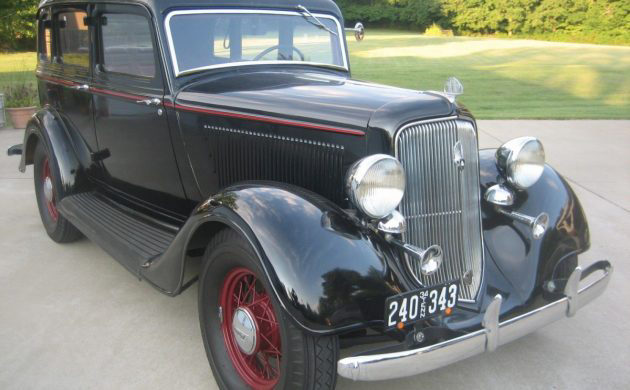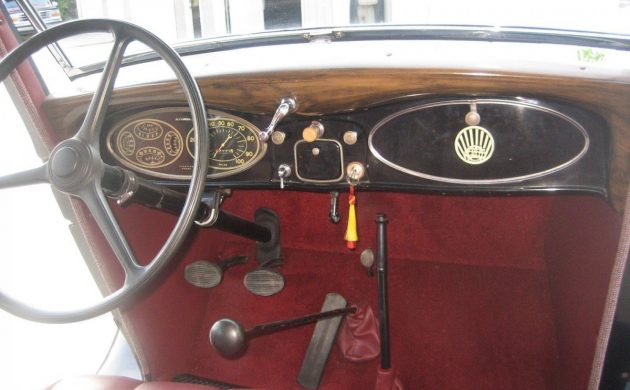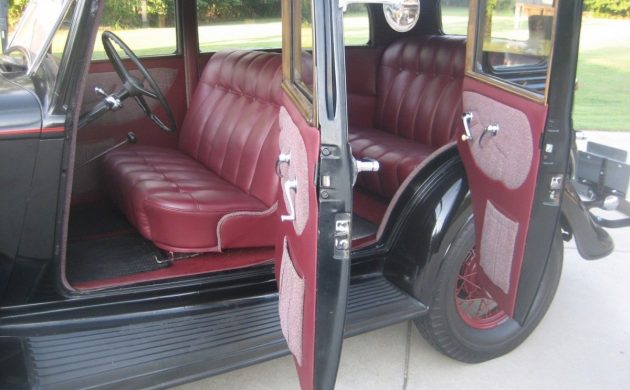In the thirties, if you wanted a fast car without spending a fortune, then you picked up a Ford. However, if you wanted an economical car with hydraulic brakes, independent front suspension, and an all steel body, then you headed down to your local Plymouth dealer. Today, Fords of this vintage bring considerably more money than comparable Plymouth models. Take for example this 1934 Plymouth sedan, found in White House, Tennessee and being sold on eBay. This running and driving Plymouth, sporting mostly original paint and a fairly new interior, is currently bid to $11,100. While that isn’t exactly a giveaway price, a comparable Ford would bring a lot more money. Is there a good reason why?
Plymouth was into the second year of production for their inline six cylinder flathead engine in 1934. This powerplant had proven to be quite reliable, and produced gobs of low end torque along with a healthy 77 horsepower. You could even order a high compression head that would bump the output to 82 horsepower. Plymouth packed this engine into four different series of cars over the course of 1934 production, which totaled 320,171 cars. During this year, according to the 1934 Plymouth page at the amazing allpar.com website, the one millionth vehicle produced by the brand was completed and displayed at the Chicago Century of Progress Exposition. It was later purchased by the same woman who bought the first Plymouth, and she ended up getting the 2,000,000th Plymouth as well in 1937!
While the number of separate models makes identifying this car difficult, it may be a PFXX. These upgraded cars were equipped with dual trumpet horns, chrome headlight surrounds, a chrome windshield frame, dual taillights, a satin finish grille, a sun visor, and a dash that was modified to offer a glovebox and an ash tray. The allpar site tells us that this version started with artillery style wheels, but wire wheels were offered later. This package made a normal Plymouth into quite a handsome automobile. The black body with dark red wheels and striping makes this particular Plymouth even more attractive.
Inside, it appears that the owner has made the car even more luxurious. The previously mentioned dash is accented by factory wood graining between the dash insert and the windshield. We can also see that the windshield still cranks out to let a lot of fresh air in. Too bad we can’t get an option like this anymore. We can also see that the maroon carpeting and boots for the shifter and the emergency brake go a little beyond what was probably an insulated rubber mat when the car left the factory.
The second interior picture reveals a much enhanced interior. We are told in the ad that the interior has been redone, but are given no information as to the material being leather or vinyl. Even if it is just vinyl, the upholstery looks inviting and comfortable. I cannot stop thinking what a fine touring car this could be.
Under the hood is an early version of the Mopar flathead inline six cylinder engine that was used in cars from 1933 through 1959. You can tell that it was an early engine by the scalloping around the bottom of the cylinder bores. Later blocks were much more squared in. Engines until 1941 had 201 cubic inches, with later engines eventually displacing 230 cubic inches. The engine ended up being produced into the seventies for commercial purposes. This one looks like it has never been out of the car. Hopefully someone has replaced the water distribution tube. These sheet metal tubes funnel water equally to the cylinders, and can cause overheating when they deteriorate and plug up passages with their remnants.
The seller tells us that this car still wears its original paint. If so, then the car’s condition is a testament to the care given it by its former owners. It appears to be a charming car built to be driven. Hopefully someone will see the bargain that these Plymouths represent in comparison to Fords of the same year. The Ford is a handsome car, but I think the Plymouth is the better car even today.













What a gorgeous car being a fan of all things Mopar I’d take this over the Ford anyway. In there time these were solid reliable cars that served their owners well. If that is original paint then it is exceptional. I sure hope then next owner continues to preserve this car as he is just a steward of it for a time. Cars of this caliber of preservation really should be on display in a car museum. It would be a treat to just have the chance to drive it.
Wow- this is in my neighborhood- and would fit in my 20’s garage. Still hasn’t met reserve though.
The question; “Is there a reason why?” is probably rhetorical, but many don’t seem to understand regardless. The line of actual buyers is longer for the Ford than the Plymouth, would be the short answer.
Another clue to help identify the model is the forged lower control arm and coil spring rather than the tubular axle with leaf springs.
Personally I like this car as it presents well and looks interesting, but I’m not a buyer. Purists will hate the non-original vinyl and tweed, near street roddy like interior. The original paint claim is not believable based on general appearance of other areas plus the replaced interior, so in the absence of documented proof it doesn’t add any believable value. If this one holds to typical ebay behavior of late, with one day left the bidding is pretty much topped out. Will the seller adjust to the market?
This is a beautifully restored car and it is no doubt a joy to drive. I drive a ’36 Plymouth coupe on occasion and it is great fun to drive and does well in everyday driving. This ’34 is no doubt an older restoration. There is no way that the paint is original, but the paint appears to have held up well since it was restored.
Wow, this brings back memories. I bought a 34 two door for 150 in 1963.
Yes it was a barn find from the Catskill mountains. Was a poor boy then, could get parts from most junk yards, starters, generators and what not were all interchangeable up to the fifties. Got is running and drove it around for a while trading it for a 57 Chevy 210 sedan. Needed more dependable transportation back n forth to community college.
i’ve been trying 2 list 10 pre 73 car’s & truck’s & it keep’s telling me blacklist spam what the f+×÷k’s the problem ¿
This is a lovely car; if I were still in Nashville I’d have to go see it! Middle Tennessee must be friendly country for old Plymouths – there was a very sweet ’33 that entered our Alfa Romeo club’s annual “Non-cours” a couple of times, and I think one year took People’s Choice.
that is my car now I bought it
the paint job was poor when your up close you can see cracking and flacking of the paint im working on the paint now over all the car was not restored it needs a trans cluch brakes wheel an master cyl rear axl seals and shoes it was a polished turd but will be right when im finished with it